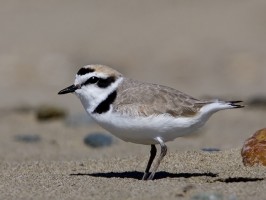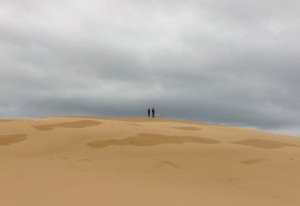The imperiled Western snowy plover needs flat, quiet beaches for nesting (ODFW). The Oregon Dunes National Recreational Area is the most extensive and unique expanse of sand dunes along the entire Pacific Coast of North America. Natural assets of the Oregon Dunes include tree islands, geologically unique sand dune formations, a variety of globally significant plant communities, rare plant and wildlife species, and numerous freshwater lakes. The area is also incredibly scenic and provides its human visitors with a host of recreational opportunities.
The problems with off-highway vehicle (OHV) use are many but revolve mainly around uneducated and illegal behavior by OHV riders, unclear delineation of closed areas, and lack of enforcement. This problem is especially critical in regards to the globally significant vegetated areas. The 1995 Oregon Dunes Plan ordered areas containing rare and sensitive native plants (called 10C) closed to cross country motorized travel. OHV riders are allowed to cross the vegetation only on designated trails to access the open sand riding areas (called 10B.)
But OHV riders did not stay on the designated legal trails. Now, nearly two decades after the Dunes Plan protected vegetated areas, they are riddled with hundreds of miles of illegal trails. Once one person creates a new illegal trail, more OHVs follow in their path, and each expand the illegal trail a little more.
In addition to the physical damage inflicted on these sensitive areas from OHV traffic, the presence of vehicles and people has had a secondary impact in the form of alien weed dispersal. For instance, prior to the illegal trail creation, many of the important plant communities did not contain Scott's broom and other invasives. Now these plants and other invasives are common, jeopardizing the outstanding Dunes native plant communities.
To add to these problems, the Forest Service mis-managed the Oregon Dunes in the 1950's by purposely planting European beach grass, trying to stabilize blowing sand. The Dunes are created and maintained naturally by blowing sand. Stabilizing the Dunes severely damaged them by not allowing blowing sand to create new dunes. Blowing sand is now caught by the European beach grass along the ocan shore, building up and creating a high "foredune" that continues to grow, starving the area behind it (called a deflation plane) of new sand.
Snowy Plover are dependent on open sand to lay their eggs, so European beach grass is harming this critically endangered bird more than motorized recreation at this point.
The Forest Service has attempted to do some restoration of plover habitat by buldozing European beach grass on some of the foredunes. They have also recently attempted to address the proliferation of motorized user-created trails by asking for public comments on a new Environmental Impact Study. More information on that study is here.
There are also wonderful areas of the Oregon Dunes that are motorized-free, with beautiful intack plant communities with safe hiking trails. The John Dellenback Trail, south of Reedsport, is one such place.
Back to the main Dunes, click here.

